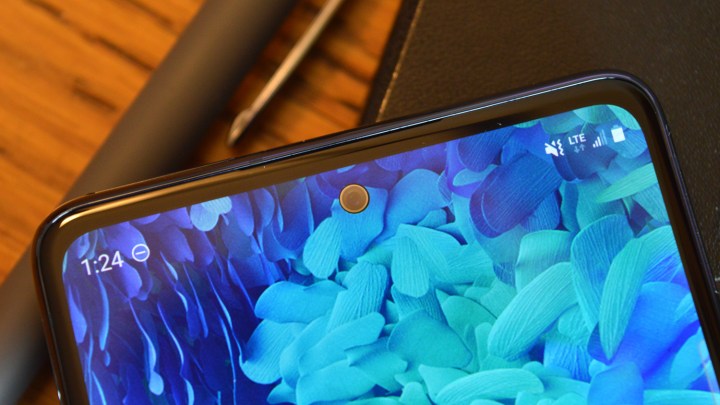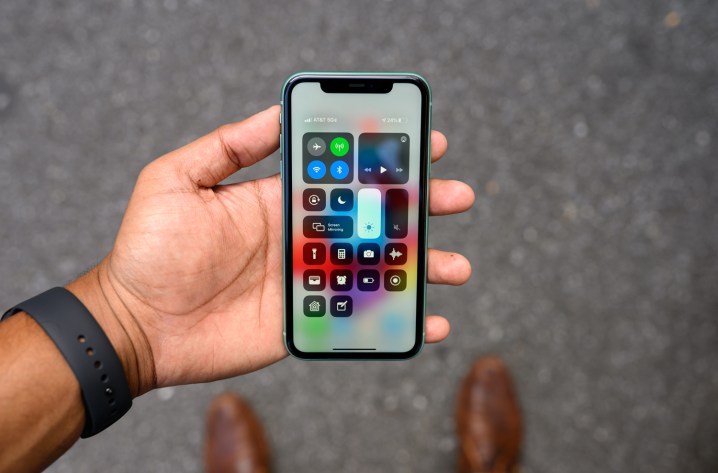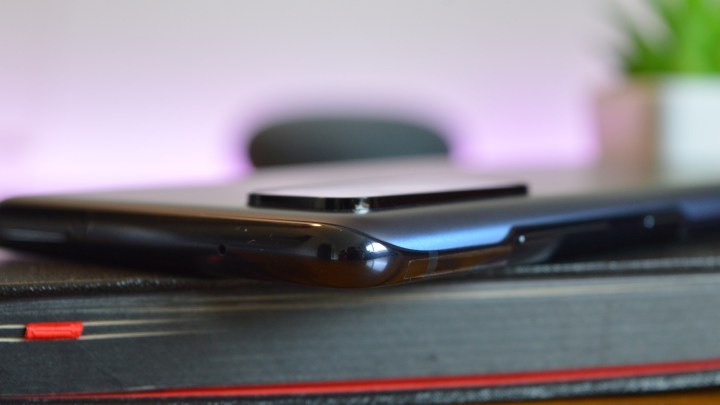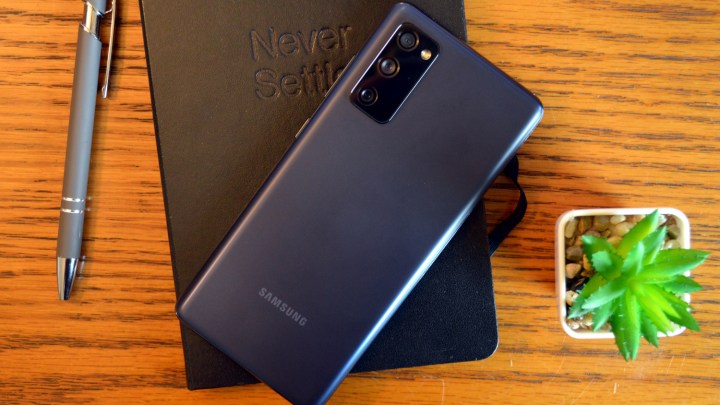The Samsung Galaxy S20 FE (Fan Edition) is Samsung’s attempt at making a less expensive version of its high-powered and popular S20 smartphones. It takes the basic concept of the Galaxy S20 and tweaks it to good effect, adding a bigger battery, a more ample screen, and an attractively-redesigned rear-camera module. Not only that, but it knocks around $300 off of the S20’s original selling price.
At $700, the S20 FE encounters a natural competitor in the iPhone 11, which also begins at $699. As with Samsung’s smartphone, Apple’s less-expensive flagship takes the core elements of pricier models and makes them more accessible, combining a high level of usability with greater respect for your budget. It’s a very good phone in its own right, but few of us have the means or desire to own two similar devices at the same time.
This means we need to clear up the question of which phone is the best. Is it the Galaxy S20 FE or the iPhone 11? We compare the two smartphones to find out and to help you decide which is the right model for you.
Specs
| Samsung Galaxy S20 FE | iPhone 11 | |
| Size | 159.8 x 74.5 x 8.4mm (6.29 x 2.93 x 0.33 inches) | 150.9 x 75.7 x 8.3mm (5.94 x 2.98 x 0.33 inches) |
| Weight | 190 grams (6.70 ounces) | 194 grams (6.84 ounces) |
| Screen size | 6.5-inch Super AMOLED capacitive touchscreen | 6.1-inch Liquid Retina LCD |
| Screen resolution | 2400 x 1080 pixels (407 pixels per inch) | 1792 x 828 pixels (326 ppi) |
| Operating system | Android 10, One UI 2.5 | iOS 14 |
| Storage | 128GB, 256GB | 64GB, 128GB, 256GB |
| MicroSD card slot | Yes | No |
| Tap-to-pay services | Samsung Pay, Google Pay | Apple Pay |
| Processor | Exynos 990 (5G version: Qualcomm Snapdragon 865) | Apple A13 Bionic |
| RAM | 6GB, 8GB | 4GB |
| Camera | 12-megapixel wide, 8MP telephoto, 12MP ultrawide rear, 32MP front | Dual lens 12MP and 12MP wide-angle rear, 12MP TrueDepth front |
| Video | 4K at 60 fps | 4K at up 60 fps, 1080p at 240 fps |
| Bluetooth version | Bluetooth 5.0 | Bluetooth 5.0 |
| Ports | USB-C, 3.1 | Lightning connector |
| Fingerprint sensor | Yes, in-display | No, FaceID instead |
| Water resistance | IP68 | IP68 |
| Battery | 4,500mAh
Fast charging (25W) Fast wireless charging (15W) |
3,100mAh
Fast charging (18W charger sold separately) Qi wireless charging |
| App marketplace | Google Play Store | Apple App Store |
| Network Support | AT&T, T-Mobile, Sprint, Verizon | T-Mobile, AT&T, Verizon, Sprint |
| Colors | Cloud Lavender, Cloud Mint, Cloud Navy, Cloud White, Cloud Red, Cloud Orange | Purple, white, yellow, green, black, red |
| Prices | $699+ | $699+ |
| Review score | 4 out of 5 stars | 4 out of 5 stars |
Design, display, and durability

The Samsung Galaxy S20 FE looks very much like the S20. It features an edge-to-edge display and the same layout of buttons and ports. It differs by featuring a “glasstic” body — basically, plastic that feels more like glass than the standard plastic you might find on a Google Pixel 4a. It also has a slightly revamped camera, which looks more like the Note 20‘s more-refined module.
As for the iPhone 11, you should know what to expect if you’ve been following Apple’s designs since the iPhone X. It features that same notch at the top of its screen, while the bezels surrounding the rest of the display are a little thicker than the S20 FE’s. It does, however, have a glass body, which is sleeker and more sophisticated than the FE’s glassy plastic.
Things change when it comes to each phone’s display. The S20 FE isn’t quite as sharp as the original S20, but with a resolution of 2,400 x 1,080 pixels and a 6.5-inch screen, it provides more pixels per inch — 407 — than the iPhone 11. Apple’s smartphone also comes with a 6.1-inch LCD screen, as opposed to the OLED displays found on the iPhone 11 Pro and Pro Max, and as opposed to the S20 FE’s Super AMOLED. Samsung’s phone also boasts a 120Hz refresh rate, making use feel smoother.
Both smartphones also have the same IP68 rating, meaning they can cope with immersion in as much as 1.5 meters of water for up to 30 minutes. Nonetheless, with a sharper screen and slightly better looks, the S20 FE wins this opening round.
Winner: Samsung Galaxy S20 FE
Performance, battery life, and charging

It’s difficult comparing the performance of Android and iOS, but here we go. The iPhone 11 features the same powerful A13 Bionic processor as the 11 Pro and Pro Max, which, in conjunction with 4GB of RAM, provides you with pretty much all the firepower you need to run the vast majority of apps. The S20 FE comes with a Qualcomm Snapdragon 865 and 6GB of RAM, but while this is 2GB more than the RAM offered by the iPhone, it will almost certainly mean that both devices perform at basically the same level. That’s because iOS and Android smartphones use RAM differently.
One small yet significant advantage for the S20 FE is that it comes with 128GB of internal storage as standard, while the iPhone 11 begins with only 64GB. The FE also houses a microSD card slot, allowing you to increase your storage even further.
On paper, you’d think that the Galaxy S20 FE would boast a much better battery life, given its cell has a 4,500mAh capacity, compared to the iPhone 11’s more modest 3,100mAh. Our reviews found that this isn’t quite the case, with the S20 FE having about 20% of juice left after a day of heavy use and the iPhone 11 having around 15% left. This may change from user to user, but with both phones basically lasting a day under solid use, they stack up largely the same in practice.
This is a tough round to call. In terms of performance and battery life, both phones are largely similar. That said, the S20 FE provides double the storage space as standard, so it just about steals the win.
Winner: Samsung Galaxy S20 FE
Cameras

The iPhone 11 packs dual 12MP ultrawide and wide-angle camera lenses, while the Samsung Galaxy S20 FE boasts a triple-lens setup, with a 12MP wide, 12MP ultrawide, and 8MP telephoto camera. Again, Samsung’s phone looks better purely in terms of specs, but performance is also a matter of camera software, and in this respect, it would seem that Apple’s device just about wins out.
As our review of the iPhone 11 found, its camera’s output is improved by such features as Smart HDR, faster autofocus, and semantic rendering, which uses artificial intelligence (A.I.) to make sense of each picture and improve its dynamics. This results in a camera that takes great shots in most situations, including in low light and at night.
The Galaxy S20 FE also provides a very strong camera experience, taking colorful and crisp pictures with a vibrant dynamic range. It also has the benefit of a telephoto lens that offers 3x optical zoom and 10x digital zoom, allowing for a hybrid zoom of 30x. However, at this maximum level, zoomed photos begin to lose detail, so it doesn’t actually confer a massive advantage over the iPhone 11.
Both smartphones can capture 4K video at 60 fps, so again, they’re evenly matched. This makes this round another tough one to call, but with an excellent Portrait Mode and slightly greater versatility, we’re giving it to the iPhone 11.
Winner: iPhone 11
Software and updates

The iPhone 11 unsurprisingly runs on iOS 14, while the Samsung Galaxy S20 FE operates using One UI 2, which is Samsung’s own skin of Android 10. It’s hard to say which is better, since each system has its own strengths and weaknesses, and your preference for one over the other is highly personal. Needless to say, iOS 14 is extremely slick, user-friendly, and secure. On the other hand, One UI 2/Android 10 offers a much higher level of customization, as well as a greater number of apps.
It’s a different story with updates. Here, there’s little doubt the iPhone 11 wins since Apple is much better at rolling out updates than Samsung. You’ll be regularly supplied with updates as an iPhone owner, while Samsung has notoriously been a little slow on the uptake with new versions of Android. You’ll also likely be supported with updates for longer, so this round is ultimately a win for Apple’s phone.
Winner: iPhone 11
Special features

While the iPhone 11 doesn’t really possess any special features not possessed by other recent iPhones, it does deliver a few things worth mentioning. Its night-mode camera feature is one of the best on the market, while its dual speakers enable surround sound, which is of surprisingly good quality. Its TrueDepth camera supports Face ID, which can be used for unlocking the phone and for payment or ID. Face ID also powers Animojis and Memojis, which are colorful, fun avatars you can create and then use during FaceTime calls (and in messages), and which move according to your own facial expressions.
The iPhone 11 doesn’t support 5G, however, which is something that the Samsung Galaxy S20 FE does (so long as you purchase the U.S. version). This is a big plus for Samsung’s phone since while 5G isn’t available everywhere, it will mean that the S20 FE offers much faster download speeds than the iPhone when you’re within a 5G area.
As we stated above, the S20 FE also supports a 120Hz refresh rate, which does enhance the quality of its screen considerably. Taken with the 5G support, this is a narrow win for Samsung’s phone.
Winner: Samsung Galaxy S20 FE
Price and availability
The iPhone 11 is available unlocked directly from Apple as well as widely available from every major carrier, and it starts at $699. The 128GB version will cost you $749, while the 256GB version ramps up to $849.
The Samsung Galaxy S20 FE starts at $699 and can be pre-ordered from Samsung. It will also be available from every major carrier and the vast majority of major retail outlets.
Overall winner: Samsung Galaxy S20 FE

The iPhone 11 is a great lower-cost smartphone, but the newer Samsung Galaxy S20 FE is slightly better. Its design is a tad more attractive, its display is noticeably sharper and smoother, it offers more storage as standard, and it also supports 5G. That’s not to say that the iPhone 11 isn’t worth getting — its performance at least matches Samsung’s phone, while its camera is a bit more versatile and effective.
Also, if you prefer iOS over Android, it almost certainly is a better buy than the S20 FE. Still, overall, the S20 FE is the better smartphone, and it’s also $50 cheaper if you compare its standard version with 128GB of internal memory to the 128GB iPhone 11.



